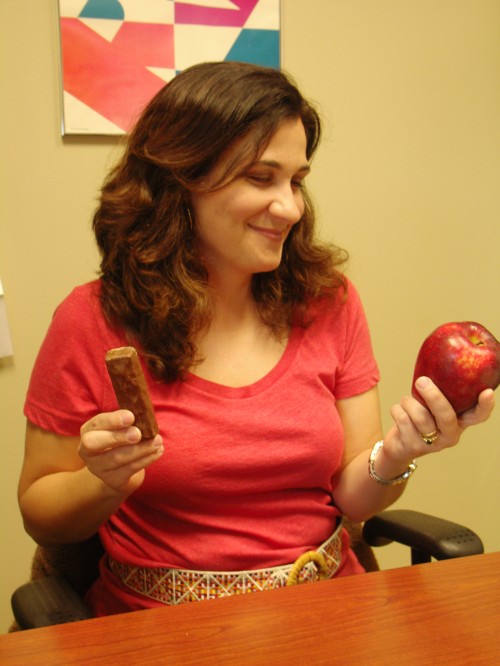Early voting begins Saturday for primary
March 14, 2012Coastal initiatives benefit region’s business, staff
March 14, 2012Bridget Scott knows people in her profession are called food police. She knows about making good choices, but realizes anxiety levels increase for most folks when they talk about healthy eating and balanced diets.
The Nicholls State University assistant professor of dietetics also knows good health outweighs pounds, and accomplishing a beneficial food lifestyle is not as difficult as it seems.
A native of Lafourche Parish, Scott grew up loving food. She knows gumbo, jambalaya, shrimp and crawfish satisfy cultural identity as well as the palate.
The good news, according to Scott, is that south Louisiana cooking need not be sacrificed for healthy living. She suggests using canola oil rather than lard when making the gumbo roux, trimming fat from meats used in jambalaya and grilling or baking shrimp and fish. She confirmed the seasoning, not frying, adds flavor to regional fare.
“Our biggest problem comes with frying foods,” Scott explained. “There are many ways to enjoy our food without frying. If you want the breading, go ahead and put it on there then bake what you were going to fry. It tastes just as good and is healthier.”
A recipe for health awareness is what this dietician wants to make her students and community appreciate.
The Louisiana Department of Health and Hospitals lists 27 percent of the state’s overall population as being obese. In Region 3, which encompasses Lafourche, St. Mary and Terrebonne parishes, the obesity rate inflates to 31.4 percent.
Nearly 34 percent of the adult U.S. population is obese according to government charts, while another 4 percent (unofficial estimates are higher) of the population exercises equally unhealthy practices with a low weight and body mass due to eating disorders.
Large charts and formulas aside, Academy of Nutrition and Dietetics lists March as National Nutrition Month. Scott explained that the designation does not mean the food police are out in force. It is offered as a starting point for public recognition of healthy lifestyle choices, which often begin not with dieting, but diet selection.
Scott explained that people do not have to completely rule out tasty treats to improve nutritional lifestyles. Often they need only reduce the quantity or frequency that culinary indulgences are enjoyed. More so, it is about eating food categories in their proper proportions.
In June 2011, the U.S. Department of Agriculture designed the MyPlate model (mimicking a pie chart) to replace the often-confusing food pyramid. By dividing the image of a plate into four color-coded sections, consumers are offered a visual tool to determine healthy portion sizes for fruits, vegetables, grains and proteins. A side dish, about the circumference of a standard coffee mug, designates how much dairy should be included in a given meal.
“The pyramid confuses a lot of people,” Scott said. “The plate is very simple because you can look at it and see that the area for the vegetable is bigger than the area for fruit, and that is bigger than proteins. The area for grains is about the same as for vegetables.” Together, vegetables and grains comprise approximately 60 percent of the plate.
Scott warns against following diets published in grocery line magazines featuring celebrities who’ve lost pounds using obscure and often unhealthy methods. “Remember, they have the lifestyle, time and money to hire personal trainers to help them with exercise programs, and have cooks preparing meals for them. Most of us don’t,” she said.
Nutritional labels on boxed and canned foods are intentional marketing tools and fail to offer realistic health guidelines. This explains how one and a half cookies becomes a serving.
For the general public, Scott admits maintaining a healthy diet is a challenge, but one that can be accomplished by making priorities, setting goals, planning meals – even a once a week splurging with pecan praline ice cream is OK – and remembering that the issue is more a matter of being healthy than weight control.
Scott said many myths persist involving nutrition, weight loss and diet, and noted that exercise along with eating right is the one detail most people neglect.
There is no one-size-fits-all measurement for proper weight because people naturally come in different heights and shapes, which make a pound of muscle more compact than a pound of fat. “You need to consult with a dietician and determine what the best fit is for you,” she said.
Research into healthy diets is ongoing. This includes work Scott is conducting to complete her doctorate degree. She is looking for pregnant women who plan on breast-feeding and are willing to participate in a nutritional study. Participants must be able to read and speak English, have access to the Internet and an ability to receive text messages. In exchange, volunteers will receive free infant-feeding education and a chance to win gift cards. Text the word “baby” to (985) 227-6466 to reach Scott.
“The bottom line is that what affects our health the most is what we are eating,” she said.
Nutritional awareness means educating people regarding individual health and dietary circumstances. What is and is not eaten enhances conditions that make people susceptible to heart disease, diabetes, osteoporosis and even issues such as depression and anxiety.
“Growing up I was always interested in health care,” Scott said. “My mom was a nurse, but I didn’t want to do that. There was something about helping people get well that always interested me. So, when it was time to pick a career, I started looking into the choices. This was really the best choice for me.”
Registered dietician Bridget Scott knows the pleasure of making health food choices and says that many myths remain concerning nutrition.









